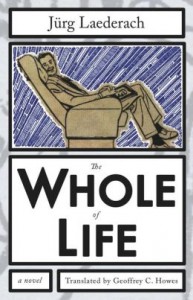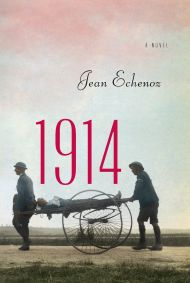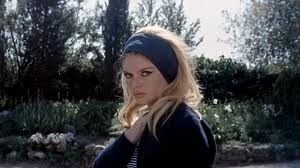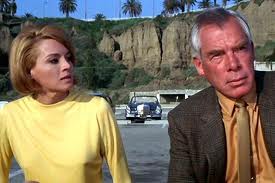The Whole of Life by Jürg Laederach
 The Whole of Life
The Whole of Life
by Jürg Laederach
Dalkey Archive Press, Jan 2014
300 pages / $15 Buy from Amazon or Dalkey Archive
Waiting for the publication of Jürg Laederach’s The Whole of Life, out now from Dalkey Archive Press, I revisited his very funny and hip 1990 Semitext(e) collection, 69 Ways to Play the Blues. Laederach is a one-time enfant terrible of Swiss literature (he writes “I’ll be called a young writer until I’m eighty,”) and his work epitomizes boomer cool. A devotee of Jazz and Downtown Music, Laederach made several trips to NYC during the 1980s. 69 Ways was written on the third trip.
Laederach is an avowed devotee of improvisational music:
69 Ways crackles with wry observations. On Bleecker Street: I am Bleecker Street, “that intersects and eschews any rude display of house numbers.”
On the view from Swiss cemeteries: “To a majority of the inhabitants of Switzerland, death, not Lake Geneva, brings about a marked improvement in their standard of living. Great pains are taken to see to it that graveyards have a “view” they are thus conceived with a strong sense of landscape and perspective.”
When authors get hungry: “All he could do was point a shaky finger at a sandwich and growl.”
The Whole of Life shares this offbeat cool. Framed as a sort of messy first-person, the plot follows a Swiss everyman, Bob Hecht, (endearingly called “My boy Bob Hecht” a la Charles Mingus: Beneath the Underdog) as he navigates mid-century industrial Europe.
The book is very funny and sprawling. The ethos of improvisation is most noticeable in Laederach’s pastichework. Different styles and references are co-opted and incorporated as a sort of self-analysis. In one section, a year of unhappy cohabitation is narrated as a boxing match. In another, he parses out the existential implications of deleting a Jewish character from the text. He has persistent dopplegangers, including a pair supposedly co-writing his memoir. The text falls into stage directions. And technical directions: “PAN F Perceptol min 68 F 10 ASA 25 DIN 15 Microphen min 20 C 4 ASA 64 DIN 19 or 68 F 5 650 ASA DIN 29 with reduction to 125 … The kind of prose we can expect in the future.” But through all this, he maintains a detached cool.
April 18th, 2014 / 10:00 am
1914 and the Madcap Cinema of Jean Echenoz
 1914: A Novel
1914: A Novel
by Jean Echenoz
The New Press, January 2014
128 pages / $14.95 Buy from The New Press or Amazon
In 1914, out this January from The New Press, Jean Echenoz turns his distinctive wit on France in the early days of the First World War. Hailed as one of the great writer’s of his generation (the so-called nouveau nouveau roman cohort of the 1980’s) Echenoz is relentless in his humor and in his antiwar message. He delivers this message through one of his favorite techniques: film parody.
Echenoz has always engaged the themes and aesthetics of cinema. His adventure novels Cherokee, Double Jeopardy, and I’m Gone, are all heavily indebted to the films of Jean Pierre Melville and Claude Chabrol. Crime tropes are consistently employed and subverted: adversaries are bound and gagged in repeated reversals of fortunes, mysterious briefcases prompt brutal killings, identical twins are separated at birth and reunited in civil wars, gun runners turn political idealists. In I’m Gone, a character complains:
“And besides… your whole deal is so cliché. They kill people like this in every TV movie in the world, there’s nothing original about it at all.”… “I don’t disagree,” Baumgartner allows, “but I admit to being influenced by TV movies. TV movies are an art form like any other.”
According to Liam Callanan of The New York Times, “Echenoz delights in savaging mass media clichés like television docudramas or action-adventure movies… dispatching them with gleeful siliness.” His 1997 Big Blondes imagines the production of a documentary film charting the history of blondes in cinema from Dietrich to Bardot. Echenoz usually favors 60s crime cinema in his novels, including entire scenes from Point Blank (1967) with Lee Marvin and Angie Dickinson, and Some Came Running (1958) with Frank Sinatra, Dean Martin, and Shirley Maclaine.

He shows a soft spot for the Rat Pack, giving Dean Martin a speaking role in Piano. Image from Some Came Running
If these previous novels engage 60s noir, 1914 is certainly an homage to the antiwar farce.
He sets the stage in 1914, with his singular ear for period detail. As in several of his earlier novel’s (Ravel, Running, and Lightning) 1914 comes off as matter-of-fact historical fiction.
February 21st, 2014 / 10:00 am
Imperial Nostalgias by Joshua Edwards
 Imperial Nostalgias
Imperial Nostalgias
by Joshua Edwards
Ugly Duckling Presse, April 2013
96 pages / $15 Buy from UDP or SPD
Joshua Edwards begins Imperial Nostalgias with two short parables. One tells the story of a Traveler, another of an Outsider. The poems are immediately evocative and irresistible in the tradition of Italo Calvino and his Invisible Cities, or more recently Srikanth Reddy’s take on Dante. From there, Edwards wades into cinematic territory in a series of photos. These describe a journey through a “Valley of Unease.” We see ruins, a stray dog, and a bonfire at night.
The third section, a prose poem called “Departures,” is the strongest in the collection. The travelogue model works as a compelling framework to satirize and embrace American anxieties in “slightly foreign” lands. The poet approaches Imperial Nostalgias with clear eyes. In an interview earlier this year with the Studio One Reading Series he admitted, “Imperialism is in the cereal I eat and the culture I consume, and the ghost of Manifest Destiny looms large in the histories of the states I’ve spent most of my life in.” Like Ben Lerner’s terrific Leaving the Atocha Station, the work engages the aesthetics and the ambivalence of young Americans abroad.
Edwards works through anxieties, but he still perpetuates the myth that there is such a place as “abroad.” So while there is little talk of the cringey Tinker, Tailor, “These boys were born to empire,” type nostalgia in the collection, there is still a very clearly articulated imperialist nostalgia. This comes out in snatches,
I wake up and then drink tea, then relax
On my friends couch to watch Paris, Texas
For the first time. When someone goes silent,
Or when a siblings room is filled with sorrow,
The whole world resembles a motel room.
Edwards chooses a very particular aesthetic (He evokes French minimalists like Toussaint, art galleries, (Like Lerner, Imperial Nostalgias repeatedly returns to art museums as if too say this too is a high concept endeavor), washed out desert scenes, vague Orientalism, Paris, Texas, etc) that effectively conveys a certain moment in American (therefore world) history: 80’s independent film and Conceptual Art.
In the translation of this aesthetic, Edwards shows a drive towards the mysterious and apophatic. When Bell Hooks wrote about Imperialist Nostalgia, she focused on celebrities like Madonna, performing blackness. She employed the now well-worn “eating the Other” type analysis. But really, it’s important to remember there’s a lot of Other there (too much to eat), and in terms of nostalgia this comes out in the apophatic or the unknowable. For 80’s Conceptual Art or even Paris, Texas, the mystery deepens as it ages. And difficult to decipher social orders become conflated with truly the truly unknowable. The work of Cindy Sherman, or Vancouver School Photographers, lately much celebrated and mimicked, have taken on a sheen of romance. And this says something about conceptual photography in the 80’s and a whole lot more about the way we live now. It’s common for artists to romanticize and re-imagine the past, but this has everything to do the artist’s personal contemporary.
For artists of a certain generation Paris, Texas becomes a type of nostalgic touchstone; it represents not a time before there was American empire, but perhaps before the artist knew about American empire. The unknown swirling around Harry Dean Stanton would be a lot less unknown for an older generation of filmgoers that had seen him act in movies beginning in the 1950’s. In a recent HMTLGIANT post, Felix Bernstein imagines art “that may or may not know (symbolic order) networks exist.” Paris, Texas is a beautiful film, certainly nostalgic for great Cowboy and Noir films of an earlier era, but the complex social networks it explores (poverty in the panhandle, cold war malaise) might be different for an older artist living in Houston, for example. Recognizing the precarious position of a would be counter-cultural American artist abroad, Edwards compulsively recreates an aesthetic of the Imaginary or in-between, when the startling symbolic order networks do not exist for him, but not an aesthetic from when they did not exist. And by translating this aesthetic again and again, Edwards is free to play Cowboys and Indians.
***
Joseph Houlihan lives and works in Minneapolis, MN.
November 4th, 2013 / 11:00 am


